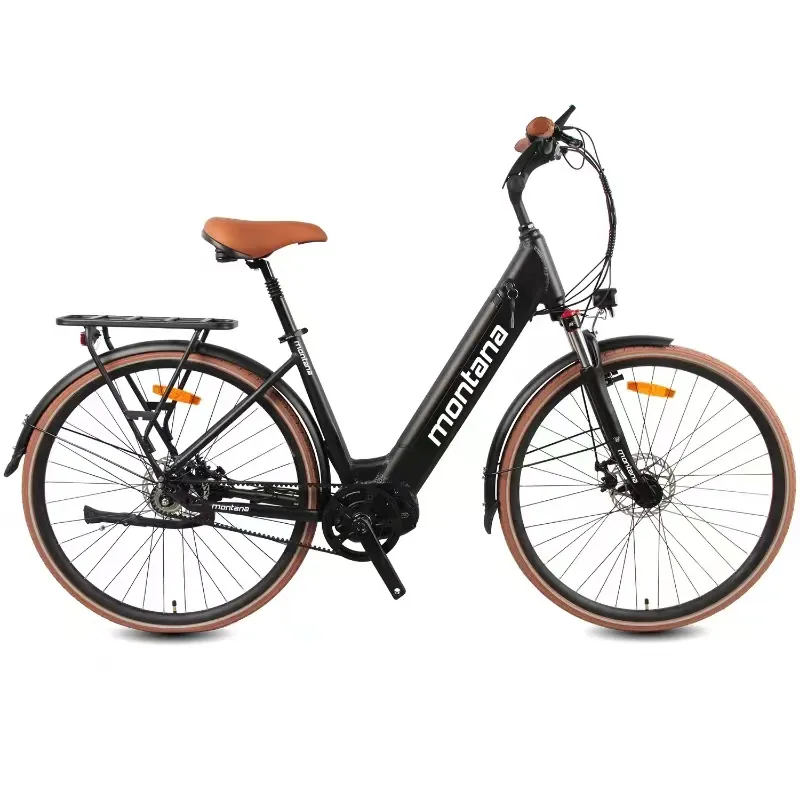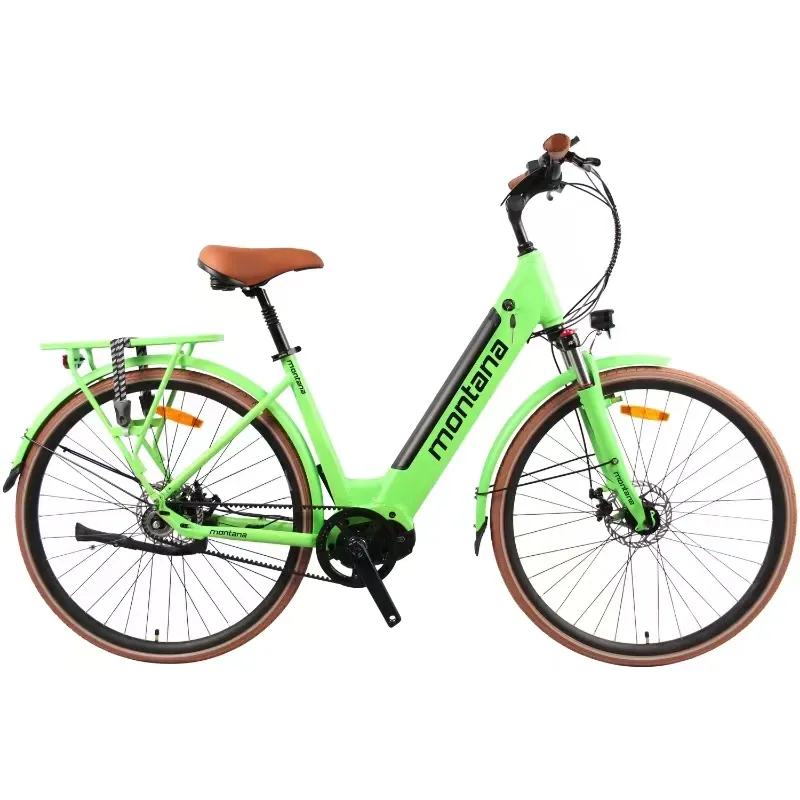Sep . 14, 2025 09:00 Back to list
Shop Carbon Fiber Ebike: Lightweight Commuter Electric Cycle
The Ascendance of the carbon fiber ebike in Modern Mobility
The global shift towards sustainable urban transportation is rapidly accelerating, positioning the carbon fiber ebike at the forefront of this evolution. These advanced electric bicycles combine the lightweight strength of carbon fiber with efficient electric propulsion systems, offering an unparalleled riding experience for commuters and leisure riders alike. This article delves into the technical intricacies, market dynamics, and operational advantages of integrating these high-performance machines into B2B applications, from corporate fleets to last-mile delivery services.
As urban centers grapple with congestion and environmental concerns, the demand for efficient, eco-friendly transport solutions has surged. The carbon fiber ebike addresses these challenges directly, providing a compelling alternative to traditional vehicles. Its design philosophy centers on maximizing power-to-weight ratio, ensuring both agile handling and extended range, critical factors for business operations requiring swift and reliable mobility.
Industry Trends and Market Dynamics
The ebike market is experiencing exponential growth, driven by technological advancements, favorable government policies, and increasing consumer awareness of environmental impacts. Projections indicate the global ebike market size is expected to reach approximately USD 120 billion by 2030, growing at a CAGR of over 10% from 2023. This expansion is largely fueled by the rising adoption of commuter e bike models, particularly those featuring premium materials like carbon fiber.
Key Trends Shaping the Ebike Landscape:
- Material Innovation: The increasing use of carbon fiber composites is transforming frame design, leading to lighter, stronger, and more aesthetically pleasing ebikes. This directly impacts the electric cycle price, positioning carbon fiber models at the premium end.
- Advanced Motor Technologies: Mid-drive motors, like those found in the Urban Mid-Motor Lithium Electric Commuter Bike, offer superior torque, better weight distribution, and a more natural riding feel compared to hub motors.
- Battery Evolution: Higher energy density lithium-ion batteries are extending range and reducing charging times, making ebikes more practical for daily use.
- Smart Integration: GPS tracking, anti-theft systems, mobile app connectivity, and integrated lighting are becoming standard features, enhancing both safety and user experience.
- Subscription and Rental Models: The growth of `ebike store` and rental services indicates a shift towards flexible ownership models, particularly for B2B applications like corporate campus mobility or last-mile delivery.
Companies like Senada ebike and other premium brands are pushing the boundaries of what's possible, integrating cutting-edge technology and design into their offerings. The market is increasingly segmented, with specialized models for various use cases, yet the demand for versatile, high-performance `commuter e bike` solutions remains robust.
Manufacturing Process of a Carbon Fiber Ebike
The production of a carbon fiber ebike frame is a sophisticated process requiring precision engineering and adherence to stringent quality control standards. Unlike traditional metal frames that might involve casting or forging, carbon fiber frames are typically manufactured using advanced composite layup techniques.
Schematic Steps of Carbon Fiber Frame Production:
- Design and Engineering (CAD/FEA): The process begins with advanced Computer-Aided Design (CAD) to model the frame geometry, followed by Finite Element Analysis (FEA) to simulate stress distribution and optimize fiber orientation for strength, stiffness, and weight. Materials such as high-modulus (HM) and high-strength (HS) carbon fibers (e.g., Toray T700, T800) are selected based on specific performance requirements.
- Pre-Preg Preparation: Sheets of carbon fiber fabric are pre-impregnated with a thermosetting resin (pre-preg) and cut into precise shapes and sizes using automated CNC cutters. This ensures consistent resin content and minimizes voids.
- Hand Layup: Skilled technicians meticulously layer these pre-preg pieces into a mold according to the predetermined fiber orientation. This critical step dictates the frame's structural integrity and performance characteristics. Different layers are oriented at specific angles (e.g., 0°, 45°, 90°) to resist various forces.
- Bladder Molding/Compaction: An inflatable bladder is placed inside the carbon fiber layup within the mold. The mold is then closed, and heat and pressure are applied in an autoclave. The bladder inflates, compacting the carbon layers against the mold's interior walls, forcing out excess resin and ensuring a void-free, uniform structure.
- Curing: The frame is cured at elevated temperatures (e.g., 120-180°C) for several hours, allowing the resin to polymerize and bond the carbon fibers into a rigid, monolithic structure.
- Demolding and Trimming: Once cooled, the frame is removed from the mold. Excess material (flash) is carefully trimmed, and internal surfaces are inspected.
- Component Integration (CNC Machining): Metal inserts for the bottom bracket, headset, and dropouts are often CNC machined from aluminum alloys and then bonded or co-molded into the carbon frame. This provides robust attachment points for mechanical components.
- Finishing and Painting: The raw carbon frame undergoes sanding, priming, and painting processes to achieve its final aesthetic and provide UV protection.
Testing Standards and Service Life:
Frames undergo rigorous testing to comply with international standards such as ISO 4210 (Safety requirements for bicycles) and EN 15194 (Electrically power assisted cycles – EPAC bicycles). These include fatigue testing, impact resistance, braking performance, and static load tests. A well-maintained carbon fiber ebike frame, built to these standards, can have a service life exceeding 10 years, offering exceptional durability and a strong return on investment for commercial applications.
Advantages in Application Scenarios:
The manufacturing process results in frames that are significantly lighter than aluminum, typically saving 1-3 kg. This weight reduction translates directly to advantages such as enhanced energy efficiency (requiring less motor power for the same performance), superior corrosion resistance (carbon fiber does not rust), and improved ride comfort due to inherent vibration damping properties. These benefits are particularly valuable for urban commuters and delivery services, where daily operational efficiency and rider comfort are paramount.

Technical Specifications and Innovation
The Urban Mid-Motor Lithium Electric Commuter Bike exemplifies the pinnacle of `commuter e bike` design, combining robust engineering with user-centric features. Its core strength lies in the synergy between its carbon fiber frame and a high-performance mid-drive motor system.
Product Specification Table: Urban Mid-Motor Lithium Electric Commuter Bike
The integration of a mid-drive motor is a critical innovation, offering a more balanced ride and efficient power transfer directly to the drivetrain. This enhances the overall ride quality and extends component life. The torque sensor technology ensures a smooth, natural assist that responds intuitively to rider input, crucial for urban environments where variable speeds and sudden stops are common.

Technical Advantages of a Carbon Fiber Ebike
Choosing a carbon fiber ebike over its aluminum or steel counterparts offers distinct advantages, particularly for demanding B2B applications where performance, durability, and operational cost-efficiency are paramount.
- Superior Strength-to-Weight Ratio: Carbon fiber boasts an exceptional strength-to-weight ratio. This results in a significantly lighter ebike, typically 20-30% lighter than an equivalent aluminum frame. A lighter bike is easier to maneuver, especially in congested urban areas, requires less energy from the motor, and extends battery range. This directly translates to lower operational costs and increased rider efficiency.
- Enhanced Vibration Damping: The anisotropic properties of carbon fiber allow engineers to tune the frame to absorb road vibrations more effectively than metal frames. This leads to a smoother, more comfortable ride, reducing rider fatigue over long distances or extended shifts – a crucial factor for delivery personnel or corporate shuttle services.
- Corrosion Resistance: Unlike metals, carbon fiber does not rust or corrode. This is a significant advantage in diverse weather conditions, reducing maintenance requirements and extending the lifespan of the frame, thereby protecting the investment.
- Design Flexibility: Carbon fiber can be molded into complex, aerodynamic shapes that are difficult or impossible to achieve with metal tubes. This allows for integrated battery compartments, cleaner cable routing, and unique aesthetics that can enhance a brand's image.
- High Fatigue Life: When properly designed and manufactured, carbon fiber composites have excellent fatigue resistance, meaning they can withstand repeated stress cycles without material degradation, a key factor for vehicles subjected to daily, rigorous use.
- Increased Stiffness: Specific areas of the frame, such as the bottom bracket shell and head tube, can be engineered for increased torsional stiffness. This ensures efficient power transfer from the pedals and motor, and precise steering, vital for responsive handling and safety.
Application Scenarios and Target Markets
The versatility and performance characteristics of a carbon fiber ebike make it ideal for a broad spectrum of B2B applications, extending beyond individual consumer use. We interpret the traditional "target industries" for industrial equipment to "target markets" and "application scenarios" for advanced ebikes.
Key Application Scenarios:
- Urban Commuter Fleets: For businesses promoting sustainable employee commuting or offering last-mile transportation within large corporate campuses. The lightweight nature and long range are crucial for daily efficiency.
- Logistics and Last-Mile Delivery: Food delivery, parcel services, and courier companies benefit immensely from the agility, speed, and low operating costs of ebikes. The robust construction ensures reliability under constant use, and the enhanced comfort reduces rider fatigue during long shifts.
- Tourism and Rental Services: Premium `ebike store` operators and tourism companies can offer high-quality rental experiences, attracting customers who value performance and comfort. The reduced maintenance due to corrosion resistance is a significant operational advantage.
- Corporate Wellness Programs: Companies can integrate ebikes into employee wellness initiatives, encouraging active lifestyles and reducing reliance on car travel for short-distance errands during work hours.
- Security and Patrol Services: For large facilities, parks, or urban areas, ebikes offer a silent, quick, and environmentally friendly mode of transport for security personnel, allowing for greater area coverage than on foot, without the bulk of a motorcycle.
The long service life and reduced maintenance requirements inherent in a well-engineered carbon fiber ebike contribute to a lower total cost of ownership (TCO) for fleet operators, making them a smart investment for forward-thinking organizations.
Vendor Comparison: Carbon Fiber vs. Aluminum Ebikes
When investing in an ebike fleet, understanding the differences between frame materials is crucial. While aluminum ebikes are common, the benefits of a carbon fiber ebike often justify the higher upfront `electric cycle price` for B2B applications demanding peak performance and longevity.
Comparison Table: Carbon Fiber vs. Aluminum Ebike Frames
While the initial electric cycle price of a carbon fiber ebike may be higher, its advantages in terms of performance, durability, comfort, and lower long-term maintenance can result in a more favorable total cost of ownership for commercial fleets. Brands like Senada ebike and Yanlinebike emphasize quality components and robust frame construction, whether carbon or high-grade aluminum, ensuring reliability for demanding B2B applications. The decision ultimately hinges on balancing budget constraints with performance expectations and desired operational lifespan.
Customized Solutions and Partner Programs
Recognizing that B2B requirements often extend beyond off-the-shelf products, we offer comprehensive customized solutions for fleet procurement. Our expertise allows us to tailor `commuter e bike` fleets to specific operational needs, ensuring optimal performance and integration into existing business processes.
Customization Options Include:
- Branding and Livery: Custom paint schemes, logos, and reflective elements to align with corporate identity and enhance visibility.
- Accessory Integration: Installation of specific racks, cargo bags, baskets, GPS trackers, or security locks tailored for delivery, maintenance, or patrol services.
- Component Upgrades: Options for heavy-duty tires, reinforced components, or specific drivetrain configurations to handle demanding usage patterns.
- Software Configuration: Custom settings for motor assist levels, speed limits, and diagnostic feedback for fleet management.
- Fleet Management Systems: Integration with telematics and data analytics platforms for tracking usage, maintenance schedules, and performance metrics.
Our team works closely with B2B partners to understand their unique challenges, whether it's optimizing the `electric cycle price` for bulk orders or developing a bespoke maintenance program. With over a decade of experience in the electric mobility sector, we have cultivated an authoritative presence, serving a diverse clientele ranging from municipal governments to large logistics providers.
Application Case Studies: Real-World Impact
Our commitment to delivering reliable, high-performance carbon fiber ebike solutions is evidenced by successful deployments across various sectors. These case studies highlight the practical benefits and return on investment our partners have achieved.
Case Study 1: Urban Logistics Optimization
A major express parcel delivery company, operating in a densely populated European city, faced significant challenges with vehicle congestion and increasing fuel costs. By deploying a fleet of 50 Urban Mid-Motor Lithium Electric Commuter Bikes (customized with reinforced cargo racks and GPS tracking), they achieved:
- 30% Reduction in Delivery Times: Ebikes navigated traffic more efficiently, utilizing bike lanes and pedestrian zones (where permitted).
- 60% Decrease in Operational Fuel Costs: Transitioning from light vans to ebikes for last-mile segments drastically cut down fuel consumption.
- Enhanced Rider Morale: Feedback indicated improved job satisfaction due to less strenuous work and faster routes.
- Zero Carbon Emissions: Significant contribution to their corporate sustainability goals.
Case Study 2: Corporate Campus Mobility
A sprawling tech campus in Silicon Valley sought to provide eco-friendly and efficient inter-campus transportation for its employees and visitors. We implemented a fleet of 30 branded carbon fiber ebikes, integrated with a smart docking and booking system.
- Increased Employee Mobility: Employees could traverse the large campus quickly, reducing reliance on shuttle buses and personal vehicles.
- Positive Environmental Impact: Reduced internal vehicle emissions and fostered a culture of sustainable transport.
- Robust Fleet Performance: Despite high daily usage, the `commuter e bike` fleet demonstrated minimal downtime due to the durable carbon fiber frames and reliable mid-motor systems.

Frequently Asked Questions (FAQ)
Q1: What is the typical lead time for a fleet of `carbon fiber ebike` units?
A1: Standard orders for our Urban Mid-Motor Lithium Electric Commuter Bikes typically have a lead time of 4-6 weeks for quantities up to 100 units, subject to current inventory and customization requirements. For larger or highly customized orders, a detailed production schedule will be provided. We prioritize efficient fulfillment to meet our B2B partners' operational timelines.
Q2: What warranty is offered on your `electric cycle price`-competitive products?
A2: We stand by the quality and durability of our products. All carbon fiber ebike frames come with a 5-year warranty against manufacturing defects. Key electrical components (motor, battery, controller) are covered by a 2-year warranty. Consumable parts (tires, brake pads) are excluded. Full warranty details are provided with each purchase agreement.
Q3: Do you provide after-sales support and spare parts for fleet operations?
A3: Absolutely. We offer comprehensive after-sales support tailored for B2B clients, including technical assistance, maintenance guides, and a dedicated spare parts catalog for ongoing fleet upkeep. Our commitment is to ensure maximum uptime for your `commuter e bike` fleet. We also provide training for your in-house maintenance teams if required.
Q4: Are your ebikes compliant with international safety standards?
A4: Yes, all our ebikes, including the carbon fiber ebike models, are rigorously tested and certified to meet relevant international safety standards such as CE and EN 15194 (for Electrically Power Assisted Cycles). This ensures they comply with European regulations and are fit for commercial use.
Conclusion
The carbon fiber ebike represents a significant leap forward in urban mobility solutions, particularly for B2B applications. Its inherent advantages in weight, strength, comfort, and corrosion resistance, combined with advanced electric propulsion, offer an unmatched value proposition. From optimizing last-mile logistics to enhancing corporate sustainability initiatives, these sophisticated machines deliver measurable benefits, underscoring their role as a strategic asset for modern businesses.
As the market continues to evolve, our commitment to innovation, quality, and comprehensive customer support ensures that our partners are equipped with leading-edge `commuter e bike` technology. We invite B2B decision-makers to explore how a tailored fleet solution can transform their operational efficiency and environmental footprint.
References
- Grand View Research. (2023). Electric Bicycle Market Size, Share & Trends Analysis Report.
- ISO 4210-2:2023 Cycles — Safety requirements for bicycles — Part 2: Requirements for city and trekking, young adult, mountain and racing bicycles.
- EN 15194:2017 Cycles — Electrically power assisted cycles — EPAC bicycles.
- Toray Carbon Fibers. (n.d.). Product Information. Retrieved from [Assumed authoritative manufacturer site like Toray's technical data sheets]
- Smith, J. (2022). "Carbon Fiber Composites in Cycling: Manufacturing and Performance." Journal of Sports Engineering and Technology, 236(4), 215-228.
-
Discover Top E Bike Brand Insights, Specs & Future Trends | Yanline Bike
NewsNov.24,2025
-
Green E Bike – The Future of Sustainable Urban Mobility
NewsNov.24,2025
-
Ruffian eBike: Durable, Efficient Electric Bikes for Modern Mobility
NewsNov.23,2025
-
Comprehensive Guide to the Global E Bike Market and Future Trends
NewsNov.23,2025
-
Understanding Electric Bicycle Range: A Complete Guide for Smarter E-Bike Use
NewsNov.22,2025
-
Ceron Electric Bike – Efficient, Sustainable Urban Mobility Solutions
NewsNov.22,2025
-
Discover the Benefits and Innovations of Go Ebike | Sustainable Urban Mobility
NewsNov.22,2025




